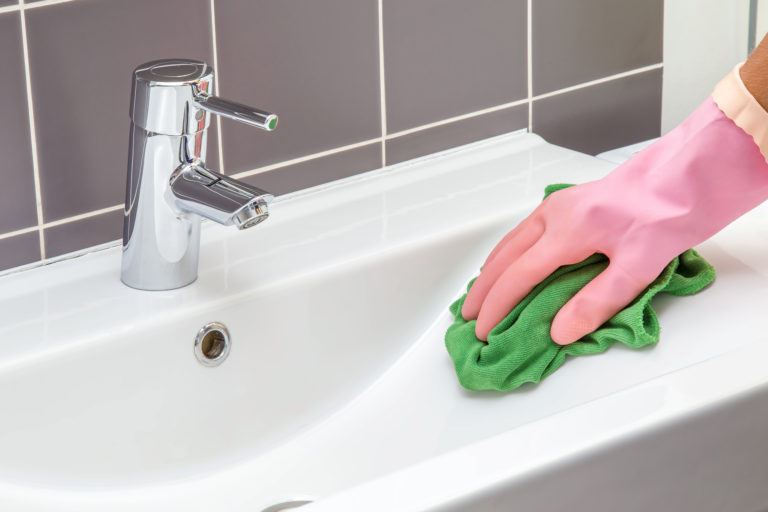
Quick Tips
- The first step to cleaning a bathroom sink is to fill a small bucket half way with vinegar
- Next, I want you to soak the entire surface of the sink with vinegar using a sponge.
- Scrub the entire surface of the sink from the top, down.
- There is no reason to rinse the vinegar off.
- Scrub the items you've been soaking and dry them off without rinsing them in water as well.
- Cleaning a bathroom sink with vinegar really does work.
You might be thinking to yourself, “I already know how to clean a bathroom sink,” and you’re probably right. It’s not a difficult task, but there is a difference between getting a sink clean and cleaning a sink. Bathroom sinks are a peculiar obstacle because they are often covered with a number of ugly substances like toothpaste, soap, makeup, hair, shavings, and mineral deposits from water.
Well, luckily for you, I’m poor. I’m always looking for the cheapest and most environmentally friendly way to accomplish my goals, and vinegar is, in my opinion, one of the best bathroom cleaning liquids out there. Not only does it kill 99% of germs and bacteria on contact, but it eats up soap scum, toothpaste, mold, mildew, and a host of other nasty messes with the greatest of ease. And so, I present to you my step-by-step of how to clean a bathroom sink with vinegar.
Note: vinegar is not recommended for natural stone tops, such as granite.
Steps to Cleaning a Sink
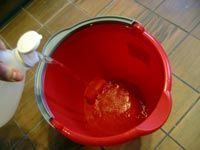 The first step to cleaning a bathroom sink is to fill a small bucket half way with vinegar, and start soaking toothbrush holders, razors and razor holders, and anything else you keep on your bathroom sink that’s been covered with toothpaste, soap, and water spots in the bucket of vinegar. Vinegar will descale and dissolve water spots and soap residues almost instantly. Usually, I try to take out the drain plug and soak that as well, but for some reason ours is bolted in.
The first step to cleaning a bathroom sink is to fill a small bucket half way with vinegar, and start soaking toothbrush holders, razors and razor holders, and anything else you keep on your bathroom sink that’s been covered with toothpaste, soap, and water spots in the bucket of vinegar. Vinegar will descale and dissolve water spots and soap residues almost instantly. Usually, I try to take out the drain plug and soak that as well, but for some reason ours is bolted in.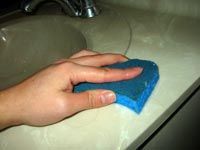 Next, I want you to soak the entire surface of the sink with vinegar using a sponge. Do this by working your way into the basin of the sink. Start at the edges by soaking the sponge in some vinegar, lightly ringing it out, and then coating each surface of your sink thoroughly. As you make your way to the basin of the sink, you can get more liberal with the application of vinegar, because this is where a majority of the soap scum and mineral deposits end up. Let that soak for a little while, maybe 5 minutes, then move on to the next step.
Next, I want you to soak the entire surface of the sink with vinegar using a sponge. Do this by working your way into the basin of the sink. Start at the edges by soaking the sponge in some vinegar, lightly ringing it out, and then coating each surface of your sink thoroughly. As you make your way to the basin of the sink, you can get more liberal with the application of vinegar, because this is where a majority of the soap scum and mineral deposits end up. Let that soak for a little while, maybe 5 minutes, then move on to the next step.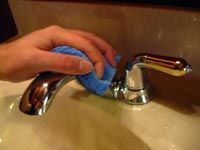 Scrub the entire surface of the sink from the top, down. By the top, down, I mean scrub toward the basin of the sink. So, start with the trim, and work your way to the edge of the sink. Then scrub the faucet really well, making sure to get at those edges where mold and mildew build up. Then scrub the soap holding areas of your sink and work your way into the basin, ending with the drain valve thing. This way, you won’t end up spreading toothpaste and mold out onto the rest of the sink.
Scrub the entire surface of the sink from the top, down. By the top, down, I mean scrub toward the basin of the sink. So, start with the trim, and work your way to the edge of the sink. Then scrub the faucet really well, making sure to get at those edges where mold and mildew build up. Then scrub the soap holding areas of your sink and work your way into the basin, ending with the drain valve thing. This way, you won’t end up spreading toothpaste and mold out onto the rest of the sink.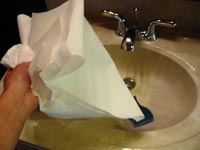 There is no reason to rinse the vinegar off. Simply wipe everything down with paper towels or a cotton cloth. There are two reasons for not splashing water all over your sink (well, three, if you include not wanting to soak the bathroom floor). First, vinegar is an antibacterial agent, and the longer it stays on your sink’s surface, the more bacteria it’s going to skill. Secondly, splashing water everywhere is only going to ruin the shine with more water spots and calcium when it dries. You want to see your sink shine, right?
There is no reason to rinse the vinegar off. Simply wipe everything down with paper towels or a cotton cloth. There are two reasons for not splashing water all over your sink (well, three, if you include not wanting to soak the bathroom floor). First, vinegar is an antibacterial agent, and the longer it stays on your sink’s surface, the more bacteria it’s going to skill. Secondly, splashing water everywhere is only going to ruin the shine with more water spots and calcium when it dries. You want to see your sink shine, right?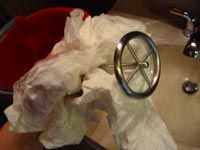 Scrub the items you’ve been soaking and dry them off without rinsing them in water as well. Well, you might want to rinse off your razor. One thing to be aware of: I forgot to take the actual razor off of my Gilette Excel, and the vinegar ate the little “moisturizing strip.” So, take that off before you soak these things. It shouldn’t take much effort to scrub the crap off those things, and drying your toothbrush holders with a paper towel will retain the shine and antibacterial effect, rather than rinsing them off with water.
Scrub the items you’ve been soaking and dry them off without rinsing them in water as well. Well, you might want to rinse off your razor. One thing to be aware of: I forgot to take the actual razor off of my Gilette Excel, and the vinegar ate the little “moisturizing strip.” So, take that off before you soak these things. It shouldn’t take much effort to scrub the crap off those things, and drying your toothbrush holders with a paper towel will retain the shine and antibacterial effect, rather than rinsing them off with water.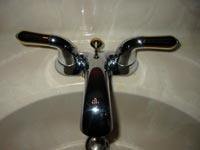 Cleaning a bathroom sink with vinegar really does work. When my girlfriend came home from work she said the bathroom sink looked brand new, like it had just been installed–and she didn’t notice any smell of vinegar either, which usually dissipates after a few hours.
Cleaning a bathroom sink with vinegar really does work. When my girlfriend came home from work she said the bathroom sink looked brand new, like it had just been installed–and she didn’t notice any smell of vinegar either, which usually dissipates after a few hours.
Commercial & Natural Bathroom Cleaners
As it turns out, a lot of people don’t trust vinegar and other natural bathroom cleaners because some of them don’t produce suds or bubbles. It’s as if that “Scrubbing Bubbles” commercial has brainwashed us into thinking that something isn’t getting clean if there aren’t suds on it. Well, that’s simply not the case, but if you’re bent on using some sort of commercial bathroom cleaner, I would suggest some of the natural options before going with something as harsh as traditional bathroom cleaning agents like Comet. You wouldn’t believe how terribly bad Comet is for your hands, your lungs, your bathroom surfaces, or the environment. Why not just go outside and dump a load of toxic waste into your backyard. Sure, we have the Comet in our house too. It sits there, unused, waiting for the day when one of us does something really stupid like spill wood varnish in the bathtub. But until that day comes, we’ll be using vinegar or environmentally friendly products like Ecover or Seventh Generation, who I believe add substances to their acid-based cleaning products to give you the suds you so desperately need to feel safe and clean.
Natural Sink Cleaners
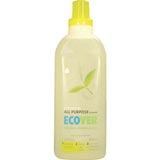 Ecover All Purpose Cleaneris a wonderful alternative to other bathroom cleaning detergents because it’s acid based–which means it eats up soap scum–and it is made with plant and mineral extracts, making it the all natural and environmentally sound solution to your bathroom cleaning troubles.
Ecover All Purpose Cleaneris a wonderful alternative to other bathroom cleaning detergents because it’s acid based–which means it eats up soap scum–and it is made with plant and mineral extracts, making it the all natural and environmentally sound solution to your bathroom cleaning troubles.
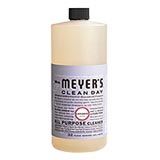 Mrs. Meyer’s All Purpose Cleaneris a natural cleaner for surfaces like granite, laminates, and sinks. I came across this one day on Amazon, and figured you might be interested in yet another natural, environmentally friendly cleaning product. I’ve yet to try it, so if you do, please email me and let me know if you like it or not. We like the lavender scent, sold on Amazon.
Mrs. Meyer’s All Purpose Cleaneris a natural cleaner for surfaces like granite, laminates, and sinks. I came across this one day on Amazon, and figured you might be interested in yet another natural, environmentally friendly cleaning product. I’ve yet to try it, so if you do, please email me and let me know if you like it or not. We like the lavender scent, sold on Amazon.